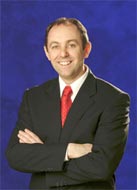Kitchen-table trader-turned-entrepreneur, Dale Gillham, started his business, Wealth Within, on a part-time basis in 2002.
Based on the advice of his wife, an information technology expert, Gillham built a website (rare for small businesses in 2002), and started a fortnightly newsletter that he has been publishing ever since – more than 10 years. “We were early adopters,” Gillham says.
Content builds trust
Over the ensuing 11 years, Gillham has become a maestro of content marketing (long before the term was coined) – building a database of 30,000 clients by sharing great content with them, winning their trust and their advocacy.
By 2003, he was creating podcasts, called Talking Wealth, using “my computer and a headset”. He added the podcasts to his newsletters, and distributed them through RSS feeds. “People liked the personal connection – the style of talking,” he says. “It was someone eavesdropping on me having a conversation with someone else, although there wasn’t anyone else. They were very personal, very much loungeroom talks.”
Developing a media profile
Gillham wrote a book when he started his company – How to beat the managed funds by 20% – which created opportunities for him to speak and write, and got him media coverage.
By 2007, he had developed a newsletter targeted at journalists, with a podcast and a short article. “The top section was always about something that had happened that week that was interesting, and the bottom was always what I thought the sharemarket would do the next week,” he says.
Radio journalists started running soundbites from these podcasts or following up on his story ideas for expert comment.
Last year, Wealth Within received 75 mentions in mainstream newspapers, on radio and on TV.
Gillham attributes this astonishing achievement to the combination of his content marketing and the services of a public relations firm, called umm.. communications, that understands his approach to marketing. “They got us straight away, and have got extraordinary results.”
Little time, little money
From the start, Gillham used content marketing because he had little money – certainly nothing like his competitors – and little time.
He has never spent more than an hour or two a week on his various newsletters and podcasts. “The more blog posts and podcasts you make, the more people forget the old ones, so you can recycle topics. I bring them up to date.”
Keep content specific
Since creating three new websites last year – DaleGillham.com, Upfront Trader and Your Trading Mentor – Gillham has appointed a staff member who spends about a day a week keeping all the content up to date.
The three websites target different demographics – investors, traders and potential traders, respectively; Wealth Within now encompasses eight different businesses and the separation makes it easier for clients.
“If you give people too much choice, they get lost. Our bounce rate was going up. These websites keep it specific,” he says. Gillham is starting to build databases for each site from scratch.
Coming soon: Paid content and videos
Video content has become simpler and cheaper to make and faster to download in the years since Gillham first gave it a try.
This year, video will be a cornerstone of his content campaign.
He’s also introducing more paid content: e-books, videos and short online courses priced around $300 to $400. “With all the data feeds on iPads and iPhones, people are becoming more attuned to video content,” he says.
Gillham’s 11-year campaign of producing reliable, valuable content for his clients has taken him from a part-time business to one with eight robust revenue streams. It wasn’t quick, he warns, especially building his database of clients and potential clients.
Gillham says: “We could buy databases, but we would be wasting our time. The people on our database have signed up – we know they are interested in what we do.”
By way of example, Gillham points to an upcoming seminar. “I was asked to do a presentation for one of the CFD (contract for difference) providers next month,” he says. “We sent out an email last week and 80 people signed up because they trust what we are going to do.”

